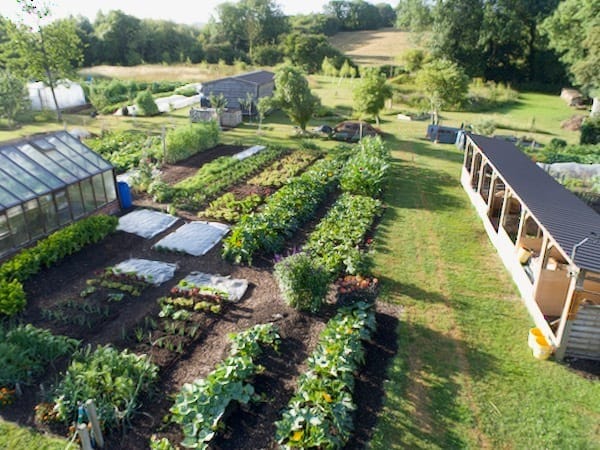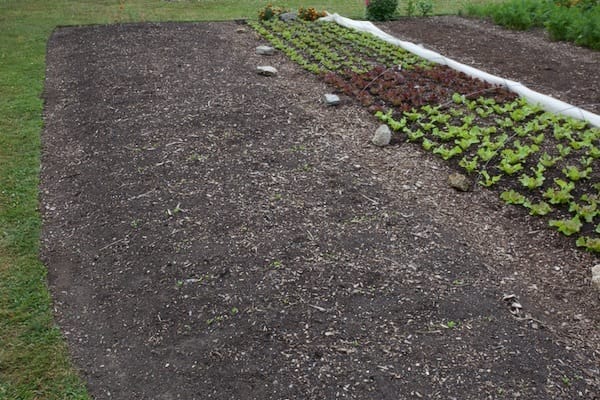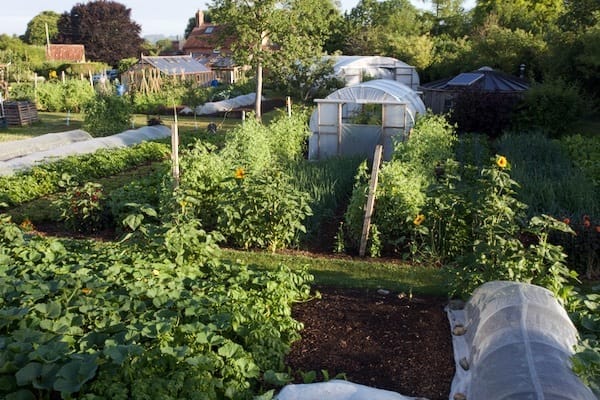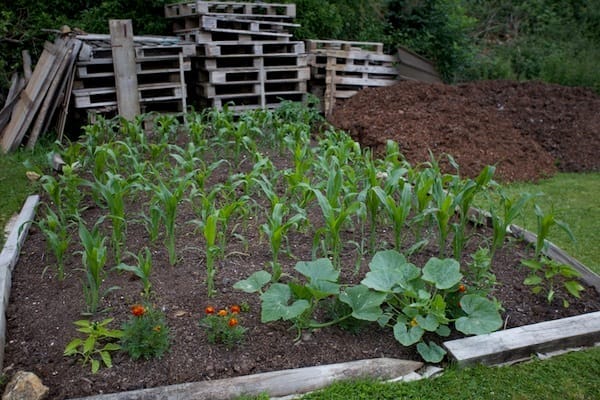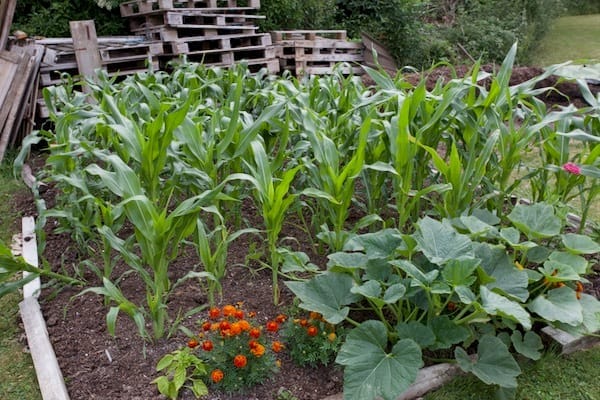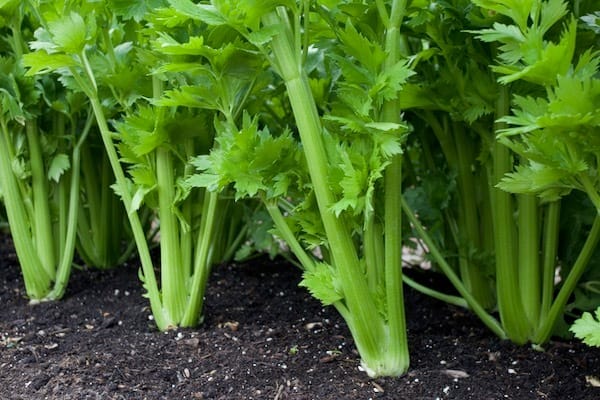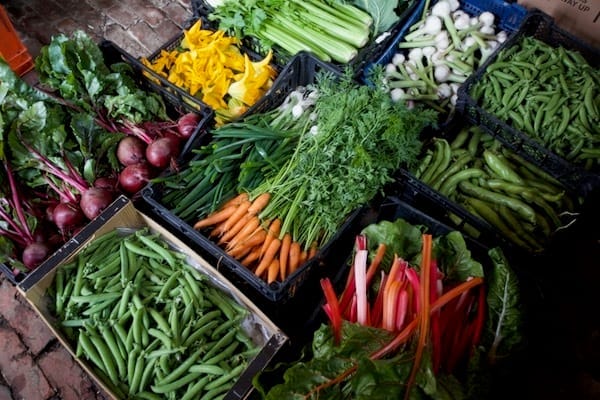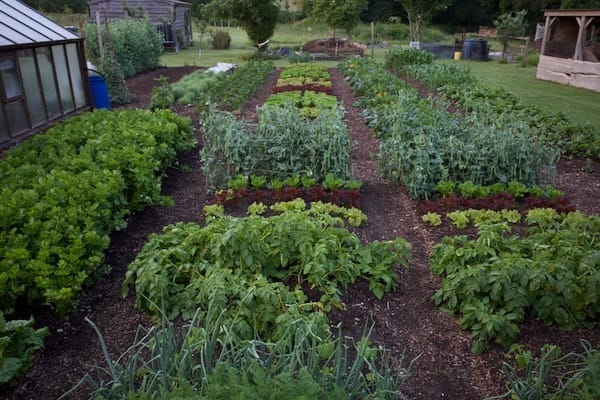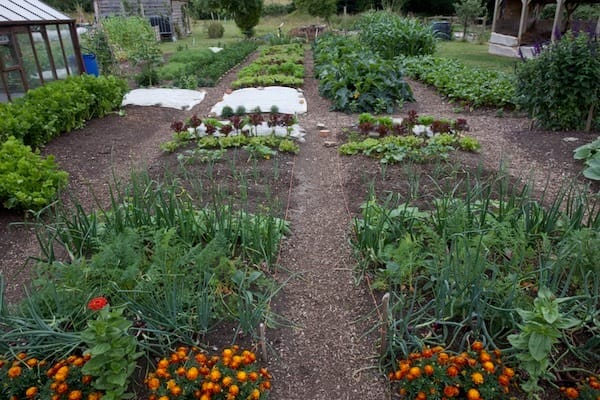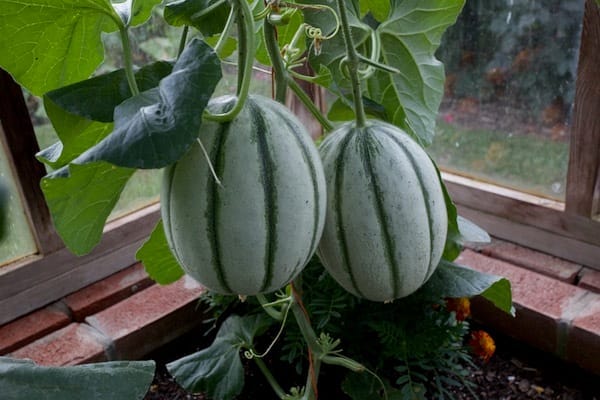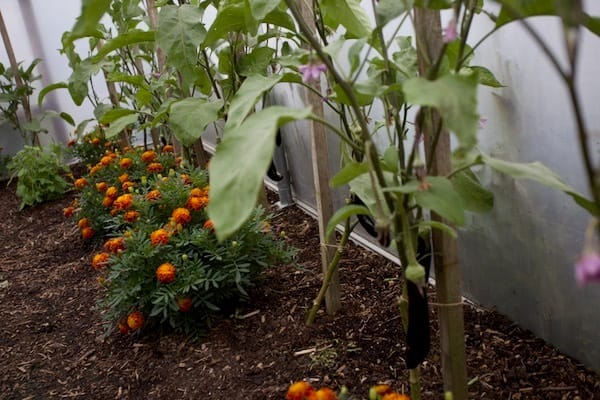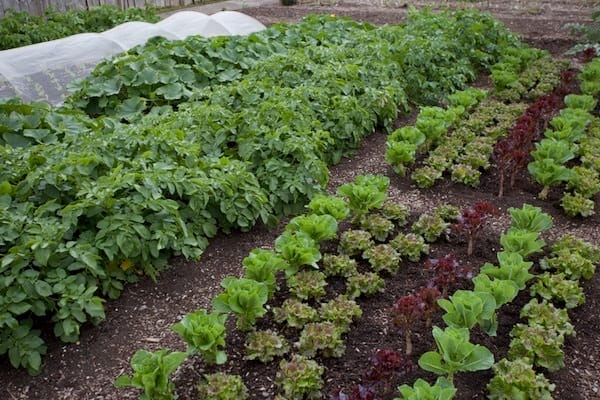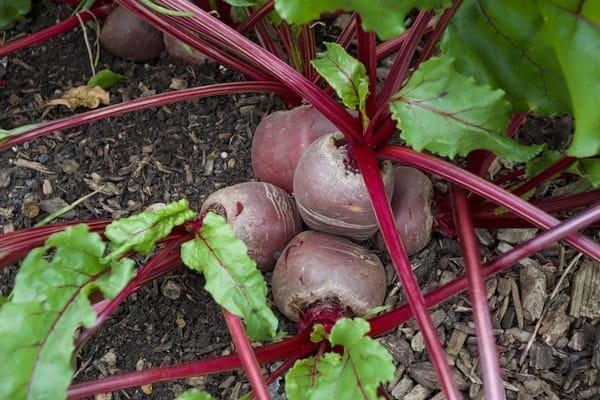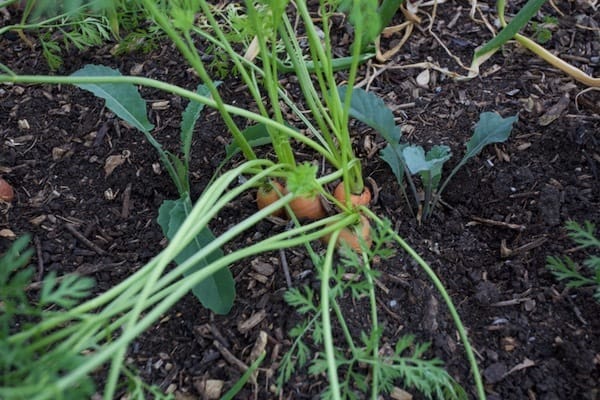Almost all beds are full. Ones which are currently empty are waiting for new seeds or plants within a week or so. There is a constant turnover at this time of year.
Showing two thirds of the cropped area, 27th June
Water Short, Sun Long
It's dry here, although we were fortunate to have 40 mm/1.6 inches of rain in June. That fell on soil already very dry from a remarkable sunny spring. In conditions like this, as long as you have sufficient water, the extra light is a positive. And no dig makes a makes a helpful difference.
See the section below on watering.
Parsnips sown three weeks ago are showing little, while and lettuce was transplanted 9 days earlier in 30C heat, is covered against rabbits and strong sun
It may reassure you to know that I can't keep up with everything. Like, parsnips we sowed in early June may not make it, only a few have emerged so far, despite a fair amount of water applied regularly.
Covers are on new plantings of lettuce and cabbage, also wild rocket. Sunflowers are early, from a sowing of 2nd April, home saved seed having extra vigour
14 day differences
Squash on 14th June. Sown 18th April and transplanted 12th May
Same squash 28th June
Incredible growth has happened and can continue
Thanks to the warmth and good light levels, I feel like I'm running every day to keep up with the extraordinary amount of new growth. The photos give an idea, 14 days apart in each case.
No dig helps massively because there is less weed pressure, and that saves so much time. Nonetheless, see the section on weeding below. It's important!
Sweetcorn 14th June. Sown 22nd April, planted here 12th May.
Same sweetcorn 28th June
Weeding, helped by no dig
Perennials in particular need constant attention. If you leave bindweed just one week, it can grow like you see in the photo and those leaves are sending energy back to the roots. Keep on it as best you can and as time allows. The soft mulch of no dig makes removal easier.
I received this comment on YouTube, highly encouraging regarding horsetail or Equisetum. Also it’s a positive affirmation of no dig.
“Horsetail has almost driven me insane but I'm winning now. It's almost given up after 2.5 years, either covered or through persistent continual removal (daily).
I did try digging over one bed to see if it would help, but I don't see it made any difference. The horsetail came back the same as in the undug bed next to it. And it dehydrated the soil. A waste of time and energy.” (from Jez Bird)
Kale, with one week’s growth of bindweed. Now removed with a trowel.
Watering
This surprised me when we had watered the bed to make it easier to transplant leeks from 7 cm pots. The holes I made with a trowel revealed incredibly dry soil deeper down. It had been growing kohlrabi, and they had clearly extracted a lot of moisture
Not everybody has dry weather, and I've heard from Cumbria, Northwest England that the weather has been endlessly grey and damp this June. I'm sorry if that's the case because sunshine powers growth.
Then there is a need to water, best done selectively. Here it’s all by hand. Water value is helped I reckon, by the magnetic field it passes through.
Celery Tango F1 transplanted 83 days ago on 4th May, sown 11th February, watered with the hose every 2-3 days
I live in the northeast of Brazil in a semi-arid climate that is very dry, and I started the no dig method and it is working very well. I have beautiful beets and cabbages in the cow manure beds.
Manoel Gustavo Sousa Vieira, YouTube
I am going to teach no dig method here in my little garden in Punta Arenas, Chilean Patagonia.
Mauricio Huerta Waiwen, YouTube
No dig harvests at Homeacres 16th June, from sowing dates in my Calendar
New No Dig Online Course
This was a big project for me, a year of taking photos and writing, some new videos.
The original No Dig online course dates mostly to 2018 and before. In the seven years since then my understandings have grown a lot. I have tried many new methods and vegetables. I share and explain the knowledge in this new version.
The two bed trial, close to camera is always giving me new ideas and understandings. It’s a living comparison of growth in soil dug once a year, and no dg, both with the same compost. This year the harvests from no dig on the right, are 15% higher than from dig on the left.
Same view 15 days later, after potato and pea harvests finished. Those spaces now have leeks, cabbage, beetroot transplanted.
In addition, Homeacres has grown considerably since 2020. In all this process, I have learned a huge amount, about starting out in particular.
Plus there is a new lesson specifically on soil biology.
And much more about making compost, and using woodchip.
Pile of newly delivered woodchip with many tree leaves, plus I watered it, impressive heat which maintained over a week at 60°C. Brilliant for making compost next year.
Anybody who has the existing No Dig online course, can upgrade automatically to the new one.
And for the next two weeks, until July 15th, we are selling the new one at half price. Even if you don't use it straight away, you have lifetime access, so grab the opportunity!
We're also running offers until 15th July on all the online courses. It's my desire to spread this wonderful knowledge as much as possible.
Find out in From Seed to Harvest how to grow cauliflowers like this Purple Graffiti
Melons in my greenhouse have grown superbly. All with compost mulch and no feeds.
Malage growing up a string, not supported, is lesson 29, also buy as a Guide
There is a pests and diseases course. I'm always looking for the simplest and most natural approach. Know your problems so you can prevent or deal with them.
The aubergines in my polytunnel are an example of that. They were covered in aphids until two weeks ago, but finally are making strong growth in the new warmth.
Also that’s because the predators have arrived, on time and as every June. I now see many ladybirds and ladybird larvae on the leaves. All I have done is to wet leaves regularly to keep aphid numbers at a lower level. They are still present and become ready food for ladybirds and hoverflies when they arrive.
Polytunnel aubergines were recently small and covered in aphids.
Protected Cropping
Question on Instagram:
Everything in my polytunnel is small this year. It’s too dry and I couldn't afford much compost as I was expanding outside the polytunnelMy answer:
A polytunnel is the highest value part of your garden or holding, and you need to reserve sufficient compost for it. That justifies and makes more of all the extra work of watering and looking after the plants in there. It should then be a haven of abundance. In the winter as well.
My 18 × 42 foot tunnel on 14th June
I am watering every two days in the heat of 26 - 30C. Plus training, pruning, even dropping Sonnenherz tomato plants already, and now harvesting.
Same view 28th June
Events, No Dig
Please see my Events page. I'm at Hampton Court this Wednesday, 2nd July. Then at Serge Hill, Tom and Sue Stuart-Smith's amazing garden for a no dig talk in the evening. On July 12th I give a talk after a garden tour at Four Acre Farm, Kate Forrester’s amazing holding near Ringwood. I think this is all sold out.
The following day, 13th July, I welcome Gaz Oakley to Homeacres and we celebrate food and fire. The next weekend I'm in Ireland at a beautiful organic garden in County Limerick. There are two one-day courses of background learning plus practical no dig in the extensive garden.
Learn techniques such as interplanting
August has me speaking at two festivals in Berkshire as it happens. One is Health and Wellness at Wasing, and one is at Hardwick estate, the Organic Growers Gathering 22nd to 24th August.
Potatoes year 11 in the same soil. I explain about no rotation in my talks and courses.
Open Day here is 6th September.
Sow now and very early July
Beetroot asap see photo Boston below
Boston multisown four months earlier, 1st March
Broccoli – Rudolph, for purple sprouting late winter to early spring, and Claret for April to May harvests, sow before 5th July
Cabbage – Savoy Vertus. also Cantasa and Wintessa F1 are good. Sown asap now, they can give welcome greens as late as March and April.
Chinese cabbage – Wong Bok or Granat or Yuki F1. My preferred sowing time is late July, for October to November harvests
Cauliflower – Romanesco to crop November. when sown now and until 5th July
Swiss Chard – Orange Glory, for plants with young vigour to overwinter as well as the harvests this autumn.
Chicory – Radicchio 506TT, for radicchios, must be sown before 10th July in order to have time for a decent heart to develop.
Chicory – Treviso 206TT, same timing as the 506, but this one makes a beautiful Treviso type, long heart, from October
Fennel – Florence, for bulbs through autumn, a long potential harvest period, when sown around the middle of July
Kale – Red Russian is such a versatile, variety, tender in salads, when pick small, or for cooking when leaves grow larger, and it often survives winter, especially when sown towards the end of July.
Kohlrabi sown around mid July should give you decent bulbs by October, and they stand some frost. I find the green varieties more productive than red ones.
Lettuce, sow mid-July for steady leaf harvests through autumn, sow batavian types from Tamar Seeds, and Saragossa is my favourite.
Interplanting
This wonderful method is the subject of a book I'm currently writing.
It's a way of economising space, and helping plants to establish thanks to shelter and mycelial interactions with existing plants. My recent video explains the method, and advantages.
Carrots harvested to make enough space for interplanting kale
Planting and where to plant
Two big understandings help me hugely in finding space to pop in new seeds or plants.
They are:
1 - With healthy and fertile, no dig soil, you do not need to worry about rotation.
Check out the photo above of year 11 potatoes in the same ground.
2 - You can pop transplants in small, and that's a lot less work than growing them larger and then needing a wider and deeper hole to put them in. The biggest positive is how they establish a lot more quickly, with reduced transplant shock.
Celery just transplanted on 25th June, sown 32 days earlier
Some plants benefit from potting on though, such as leeks. So they keep growing while earlier plantings finish, such as potatoes.



